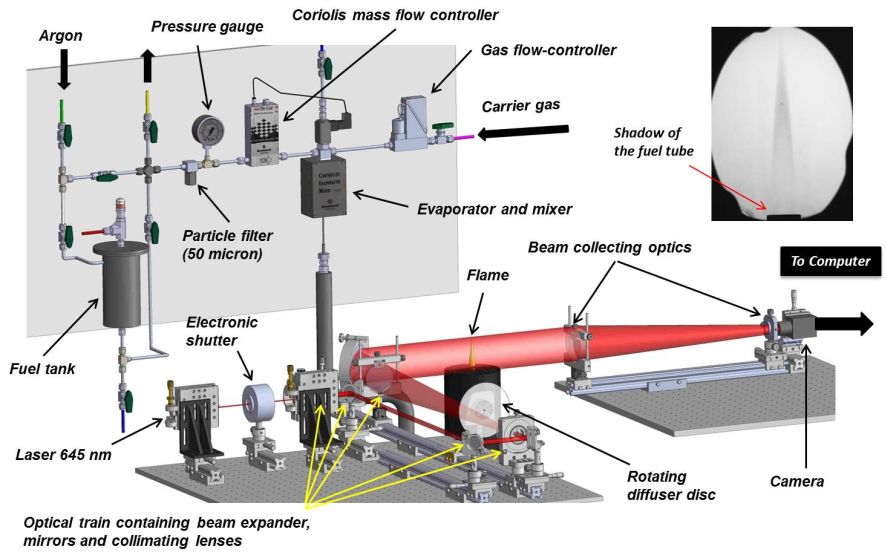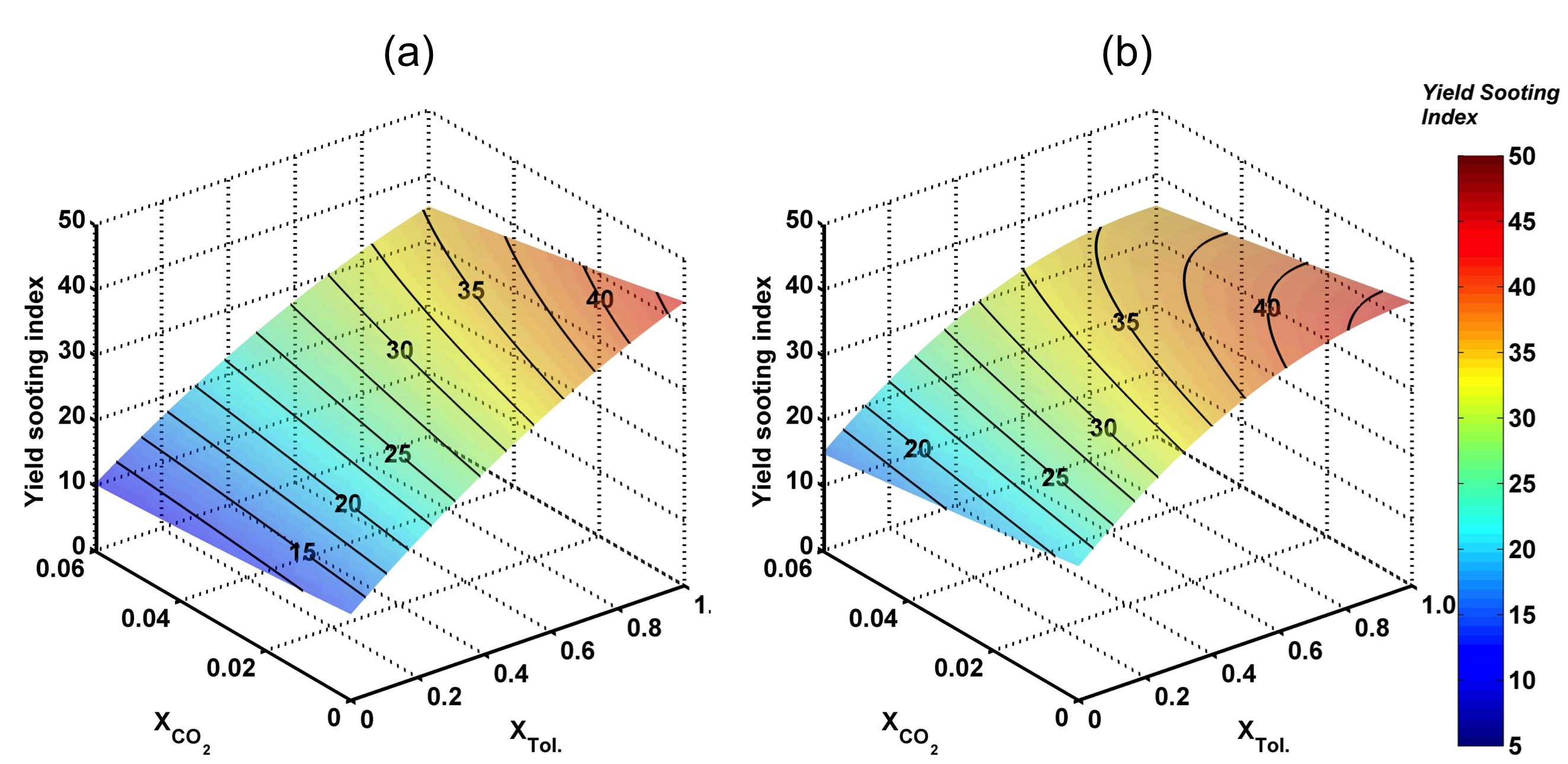Follow here the studies that aim at the quantification of the soot production by alternatives fuels.
Recent related publications:
M. Kashif, J. Bonnety, P. Guibert, C. Morin, and G. Legros. Soot volume fraction fields in unsteady axis-symmetric flames by continuous laser extinction technique. Optics Express, 20:28742–28751, 2012 [link].
M. Kashif, J. Bonnety, P. Guibert, and G. Legros. Sooting tendencies of primary reference fuels in atmospheric laminar diffusion flames burning into vitiated air. Combustion & Flame, 161:1575–1586, 2014 [link].
J.-L. Consalvi, F. Liu, J. Contreras, M. Kashif, G. Legros, S. Shuai, and J. Wang. Numerical study of soot formation in laminar coflow diffusion flames of methane doped with primary reference fuels. Combustion & Flame, 162:1153–1163, 2015 [link].
M. Kashif, J. Bonnety, A. Matynia, P. Da Costa, and G. Legros. Sooting propensities of some gasoline surrogate fuels: combined effects of fuel blending and air vitiation. Combustion & Flame, 162:1840–1847, 2015 [link].
G. Legros, Q. Wang, J. Bonnety, M. Kashif, C. Morin, J.-L. Consalvi, and F. Liu. Simultaneous soot temperature and volume fraction measurements in axis-symmetric flames by a two-dimensional modulated absorption/emission technique. Combustion & Flame, 162:2705–2719, 2015 [link].
J. Abboud, J. Schobing, G. Legros, J. Bonnety, V. Tschamber, A. Brillard, G. Leyssens, V. Lauga, E.E. Iojoiu, and P. Da Costa. Impacts of oxygenated compounds concentration on sooting propensities and soot oxidative reactivity: Application to Diesel and Biodiesel surrogates Fuel, 193:241-253, 2017 [link].
J.-L. Consalvi, F. Liu, M. Kashif, and G. Legros. Numerical study of soot formation in laminar coflow methane/air diffusion flames doped by n-heptane/toluene and iso-octane/toluene blends. Combustion & Flame, 180:167-174, 2017 [link].
J. Abboud, J. Schobing, G. Legros, A. Matynia, J. Bonnety, V. Tschamber, A. Brillard, G. Leyssens, P. Da Costa. Impacts of ester's carbon chain length and concentration on sooting propensities and soot oxidative reactivity: Application to Diesel and Biodiesel surrogates Fuel, 222:586-598, 2018 [link].
H. Zhang, O. Pereira, G. Legros, E.E. Iojoiu, M.E. Galvez, Y. Chen, P. Da Costa. Structure-reactivity study of model and Biodiesel soot in model DPF regeneration conditions. Fuel, 239:373-386, 2019. [link].
J. Bonnety, A. Guibaud, R. Jalain, A. Matynia, J.-L. Consalvi, F. Liu, G. Legros. Probing the local radiative quenching during the transition from a non-smoking to a smoking laminar coflow ethylene/air non-premixed flame. Combustion & Flame, 203:120-129, 2019 [link].
Rationales
The growing concerns about increasing energy demand, energy efficiency policies, energy security issues, hazardous effects of combustion-related emissions on human health, and global warming change have led to more and more stringent regulations on exhaust emissions from combustion devices, and especially on soot release.
The recent legislation and guidelines to mitigate emissions related problems prescribe the integration of renewable fuels into the transportation fuel pool and the use of high-efficiency combustion devices to reduce CO2 emissions. These challenges can be converted into opportunities through a careful selection of renewable/alternative fuel compositions and efficient advanced combustion processes.
Alternative and biofuels exhibit a wide range of combustion characteristics and induce different effects on combustion processes, and therefore ultimately on exhaust emissions. Hence, mixtures composed of alternative fuels could be designed specifically to comply with a set of requirements, for instance, to reduce soot.
Works at ∂'Alembert
The concept that drives our works is the Yield Sooting Index (YSI) that McEnally and Pfefferle suggested in the 2000s. This standard test intends to evaluate the sooting tendency of any fuel. This procedure is the first one to infer the index from direct measurement of soot concentration, called soot volume fraction. Measuring the peak soot volume fraction fv,max in a flame established in standardized conditions indeed allows the YSI of the burning fuel to be inferred as follows:
![]()
The schematic below introduces the experimental setup that has been developed at Inst. ∂'Alembert to allow the standardized conditions to be established, therefore the YSIs to be measured. Upstream the burner above which the flame is established, a specific setup has been designed to evaporate the liquid fuel whose sooting tendency is to be evaluated. The vapors are then mixed to a carrier gas, i.e. a mixture composed of methane and nitrogen. In the absence of vapors, the flame established over the burner hardly produces soot. As a result, in the presence of vapors, the sooting tendency is attributed to the liquid fuel that has been vaporized.

Figure 1: experimental arrangement for the measurement of the Yield Sooting Index of the liquid fuel filling the fuel tank. The insert in the upper right corner shows a typical frame recorded by the camera that captures the absorption of the laser beam crossing the flame.
Within the context of these works, the soot volume fraction field is mapped by the measurement of the absorption of a laser beam that crosses the flame. With a wise selection of the operating laser wavelength, this absorption of the light can be attributed to soot particles. Then some theoretical considerations allow the soot volume fraction to be inferred from the absorption field measured over the sensor of a camera (see the conical soot layer absorbing the laser light over the burner tip in the insert shown in Fig.1).
Figure 2 illustrates how the composition of a fuel blend can influence the sooting tendency. Here, toluene is blended with either n-heptane or isooctane. These kinds of blends are considered as commercial gasoline surrogates. XTol. is toluene mole fraction in the blend. Figure 2 also shows the mitigation of YSI, i.e. soot production, when CO2 is added to the oxidizer (air), XCO2 being the CO2 mole fraction in this oxidizer. This represents an assessment of the effect of Exhaust Gas Recirculation (EGR) on particulate matter emission by Internal Combustion engines.

Figure 2: surfaces modeling the evolution of YSI as a function of CO2 mole fraction (XCO2) in the coflowing air and toluene mole fraction (XTol.) in the blends of: (a) n-heptane/toluene; (b) isooctane/toluene.
Combined effects of fuel blend and CO2 dilution of the oxidizer may then be revealed. While the YSIs of the n-heptane/toluene blends exhibit pretty linear responses when both XTol. and XCO2 are modified (see the linear isolevels of YSI in Fig.2(a)), the YSIs of the isooctane/toluene blends show more sophitiscated trends (see the curved isolevels of YSI in Fig.2(b)). As shown by the discrepancy between both behaviors, very similar fuels may exhibit quite different responses to strategies aiming at the reduction of soot production, such as CO2 adddition. For this reason, the YSI methodology looks promising as an a priori step for fuel design.
Prospects
Within the context of Johnny Abboud's PhD, we will investigate the influence of oxygenated compounds on the YSI of biofuels. We are wondering whether a correlation can be extracted between the YSIs of biofuels and the reactivity of the soot particles that these biofuels produce. As pressure may have a strong influence, we are also designing a burner that will operate at pressure ranging from 1 to 10 atm.